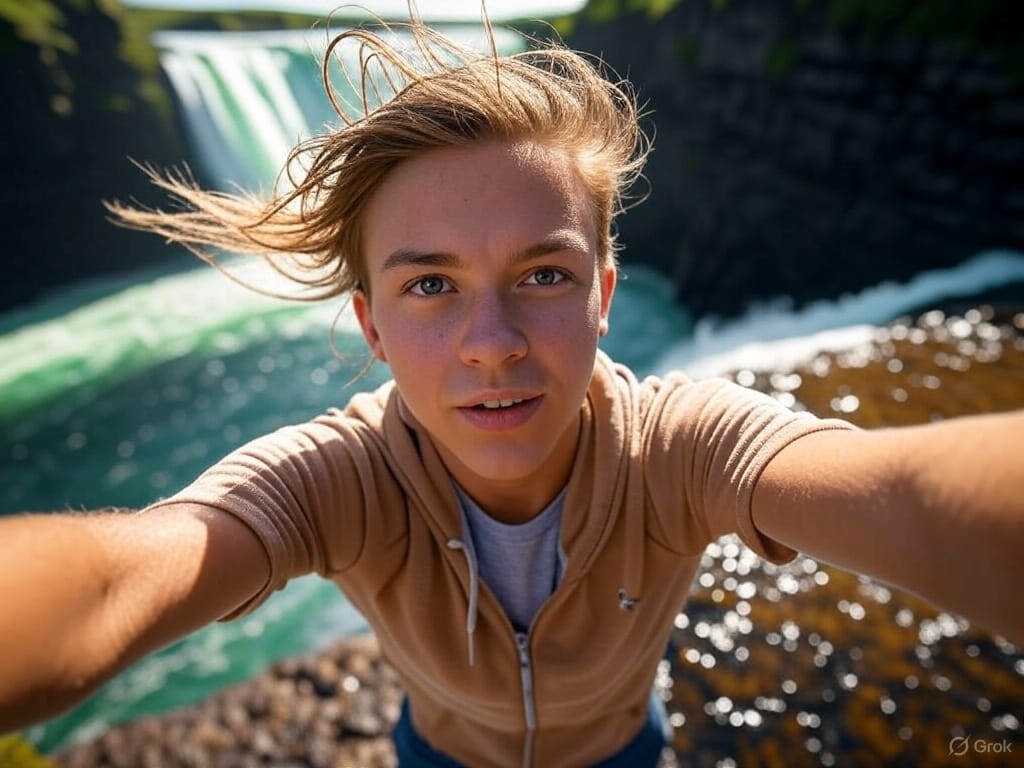
By Elke Porter | WBN News Global | May 10, 2025
In the age of social media, the quest for viral fame has turned breathtaking landscapes and daring stunts into stages for influencers chasing the perfect photo or video. Platforms like TikTok and Instagram reward eye-catching content with likes, follows, and potential brand deals, but this pursuit comes with a steep and often overlooked cost.
Over the past decade, hundreds of influencers and thrill-seekers have lost their lives attempting to capture that one iconic shot, falling from cliffs, waterfalls, and tall buildings. This article explores the alarming trend of selfie-related deaths, the high risks of being a social media influencer, and why so many fail to recognize the dangers until it’s too late.
Growing Toll: Selfie-Related Deaths on the Rise
Since the rise of smartphones and social media, the phenomenon of “selfie deaths” has become a grim reality. A 2022 study published in the Journal of Travel Medicine documented 379 selfie-related deaths worldwide between 2008 and 2021, with falls from heights—particularly cliffs and waterfalls—accounting for about 50% of these incidents. The numbers are likely under reported, as many cases go undocumented in media or occur in regions where reporting is limited. A 2018 study by Indian researchers noted 259 deaths between 2011 and 2017 alone, highlighting how the trend has escalated with the growing popularity of platforms like Instagram and TikTok.
High-profile cases underscore the scale of the issue. In 2021, Hong Kong influencer Sofia Cheung, aged 32, fell to her death while taking a selfie at the edge of a waterfall in Ha Pak Lai park. Known for her daring cliffside photos, Cheung’s tragic end shocked her 35,000 Instagram followers. Similarly, in 2024, 27-year-old Indian influencer Aanvi Kamdar plummeted 300 feet into a gorge while filming a video near Kumbhe waterfall for her Instagram. In 2017, Chinese rooftopper Wu Yongning, a popular influencer with a large following, fell from a 62-story skyscraper while filming a stunt without safety gear. These are not isolated incidents but part of a broader pattern where influencers risk everything for social media clout.
Why Influencers Take the Risk
The allure of social media fame is a powerful motivator. Platforms like TikTok and Instagram thrive on visually stunning or adrenaline-pumping content, and influencers are rewarded with likes, shares, and sponsorships for pushing boundaries. As psychiatrist Enrique García Bernardo explains, “Social networks reward the most extreme content… The prize for taking a very risky selfie is social standing and this gives you a rush of adrenaline for every ‘like’ that you receive.” This dopamine-driven feedback loop encourages influencers to escalate their stunts, often without fully weighing the consequences.
The pressure to stand out in a crowded digital space also plays a role. With millions of creators vying for attention, influencers feel compelled to produce increasingly daring content to break through the noise. A 2019 Fast Company article noted that risk-taking social media photography deaths tripled from 2014 to 2015, coinciding with the viral spread of “rooftopping” after Canadian photographer Tom Ryaboi’s daring 2011 photo from a Toronto skyscraper. The promise of fame, followers, and financial rewards—such as brand deals or TikTok Shop earnings—drives influencers to climb higher, lean closer, and ignore warning signs.
Younger influencers, particularly those in their teens and early 20s, are especially vulnerable. A 2018 study found the average age of selfie-death victims was around 22, with many being tourists or thrill-seekers chasing picturesque backdrops. In 2024, 14-year-old TikTok star Moe Sa Nay drowned after slipping while taking selfies at Sinywa Waterfall in Myanmar, her body trapped between boulders as rescue workers struggled to reach her. Adolescents, still developing their sense of risk and identity, are particularly susceptible to peer pressure and the desire to emulate viral trends.
The Hidden Dangers of Influencer Culture
Being a social media influencer is often glamorized as a dream job—travelling to exotic locations, snapping stunning photos, and earning a living through sponsorships. Yet, the physical and psychological risks are rarely discussed. Unlike traditional stunt performers, who use safety gear and professional training, most influencers operate without precautions, relying on sheer bravado or ignorance of the dangers. A 2023 Forbes article highlighted how social media platforms amplify this issue by showcasing curated, idealized shots that obscure the failed attempts or near-misses behind the scenes.
The environments influencers seek out—cliffs, waterfalls, and skyscrapers—are inherently treacherous. Wet rocks, unstable ledges, and strong currents make waterfalls particularly deadly, as seen in cases like Cheung’s and Kamdar’s. Rooftopping, where influencers scale tall buildings without harnesses, carries the obvious risk of fatal falls, as evidenced by Wu Yongning’s death. Even seemingly safe locations can turn deadly; in 2019, a couple fell 800 feet from a cliff in Yosemite National Park, likely while posing for an Instagram photo.
Public perception often downplays these risks, with some blaming victims for their recklessness. Comments on articles about Kamdar’s death included harsh judgments like, “That’s what happens when you’re focused on your phone and not your surroundings.” However, this overlooks the systemic pressures of influencer culture, where algorithms favor extreme content and followers demand ever-more-spectacular posts. As media scholar Ricky D. Crano notes, “We must compete with others just to be seen—that is, for the algorithm to favour our post.”
A Call for Awareness and Prevention
Despite the growing death toll, many influencers and their followers remain unaware of the risks. Social media platforms, while not directly encouraging dangerous behaviour, have been criticized for failing to moderate hazardous content effectively. A 2023 PetaPixel article suggested that “no selfie zones,” physical barriers, and better signage at dangerous locations could reduce incidents, but such measures are inconsistently implemented. In Australia, land managers at cliffside tourist spots have reported struggling to manage crowds drawn by social media, with some ignoring fences and warnings.
Education is another critical tool. Influencers need to be informed about the real dangers of their stunts, and followers should be encouraged to value authenticity over spectacle. Social media companies could play a role by promoting safety campaigns or penalizing content that glorifies risky behavior, though current efforts—like TikTok’s “professional stunt” disclaimers—are often inadequate.
Conclusion: A Life Worth More Than a Like
The pursuit of the perfect TikTok or Instagram shot has claimed far too many lives, from seasoned influencers to young dreamers chasing fame. The stories of Sofia Cheung, Aanvi Kamdar, Wu Yongning, and others serve as stark reminders that no photo is worth a life. Even in Canada, anya Pardazi, a 21-year-old philosophy student and TikTok influencer, fell to her death during a skydiving accident, making her at least the fourth such person killed during the extreme sport in the summer of 2022 in Canada.
Yet, the pressures of influencer culture—fuelled by algorithms, followers, and the promise of stardom—continue to push people toward deadly risks. As social media evolves, it’s time for creators, platforms, and audiences to prioritize safety over sensationalism. After all, the true measure of influence isn’t a viral post but the ability to inspire others to live fully, safely, and authentically in the real world.
#Influencer Risks #Selfie Deaths #Social Media Dangers #TikTok Risks #Instagram Fame #Viral Stunts #Safety First #Influencer Culture #WBN News Global #Elke Porter
Connect with Elke at Westcoast German Media or on LinkedIn: Elke Porter or contact her on WhatsApp: +1 604 828 8788


